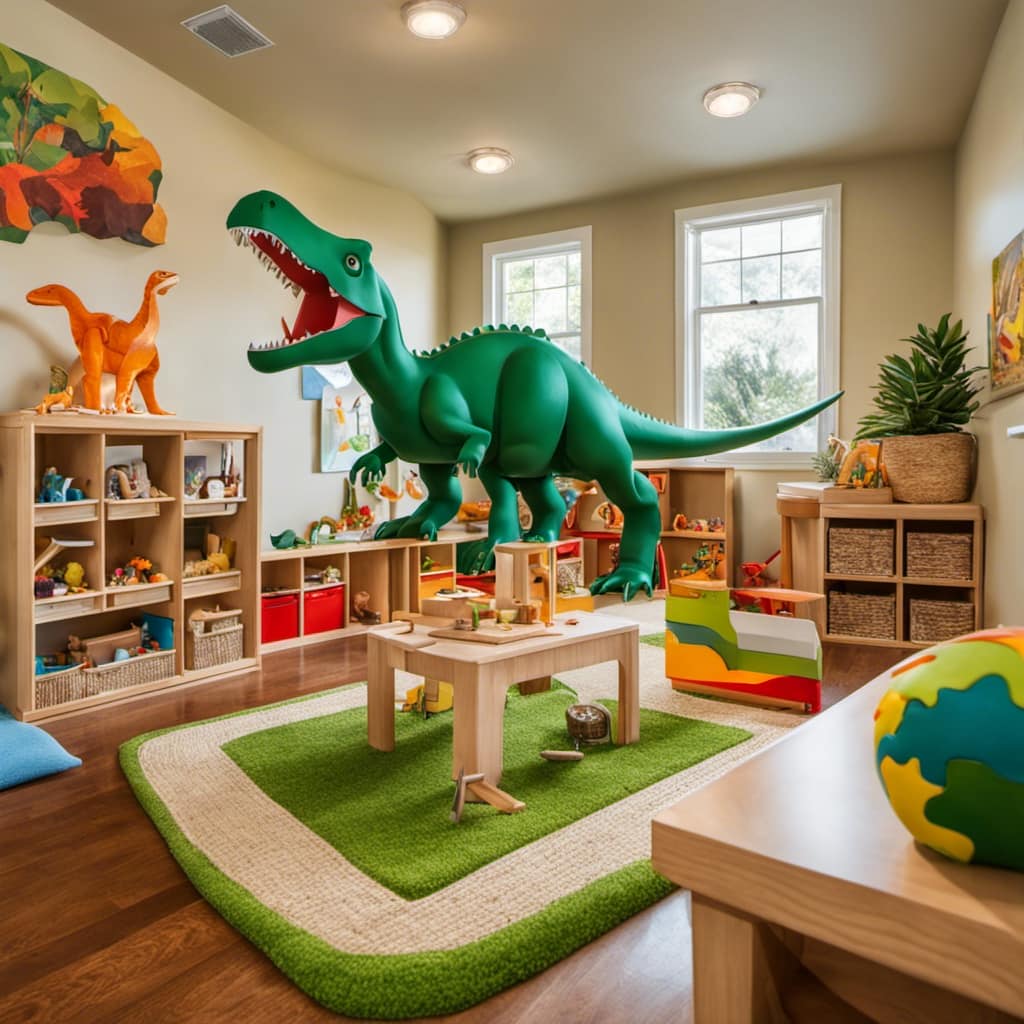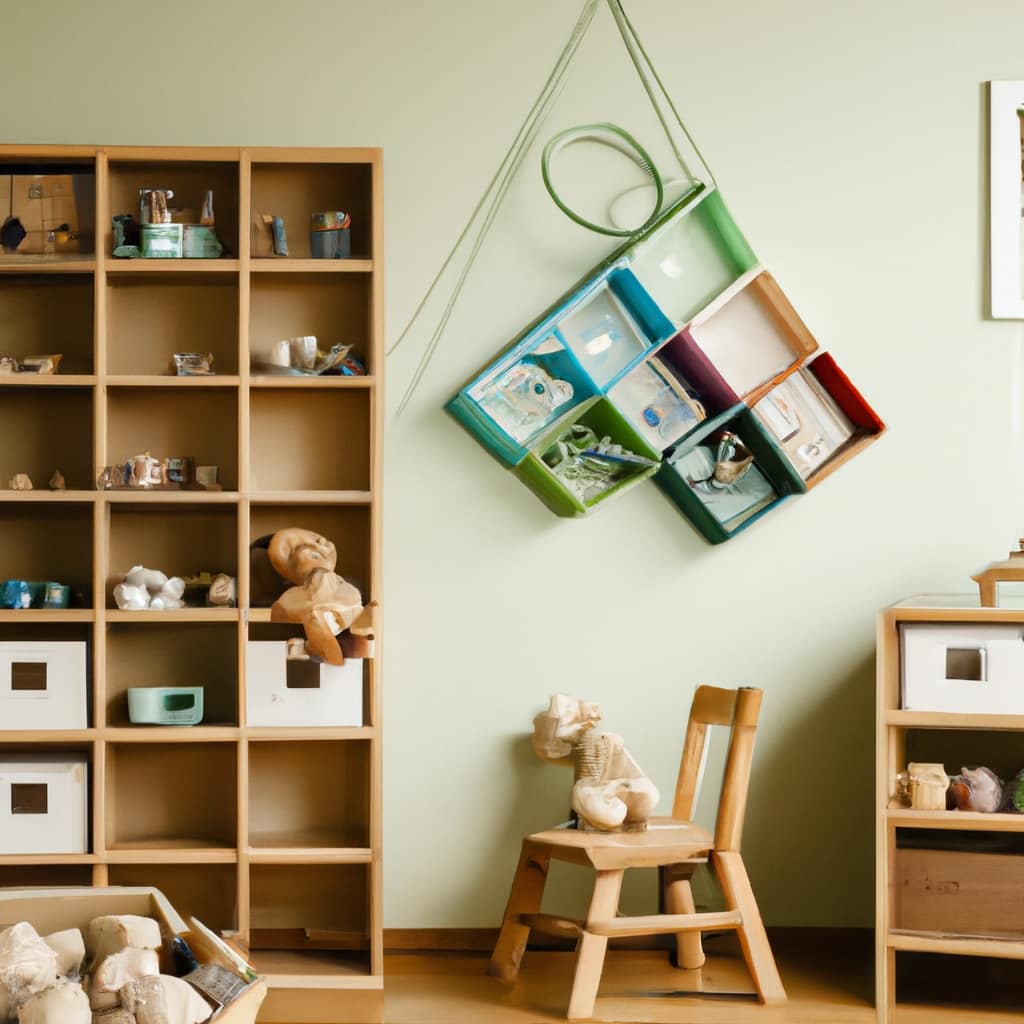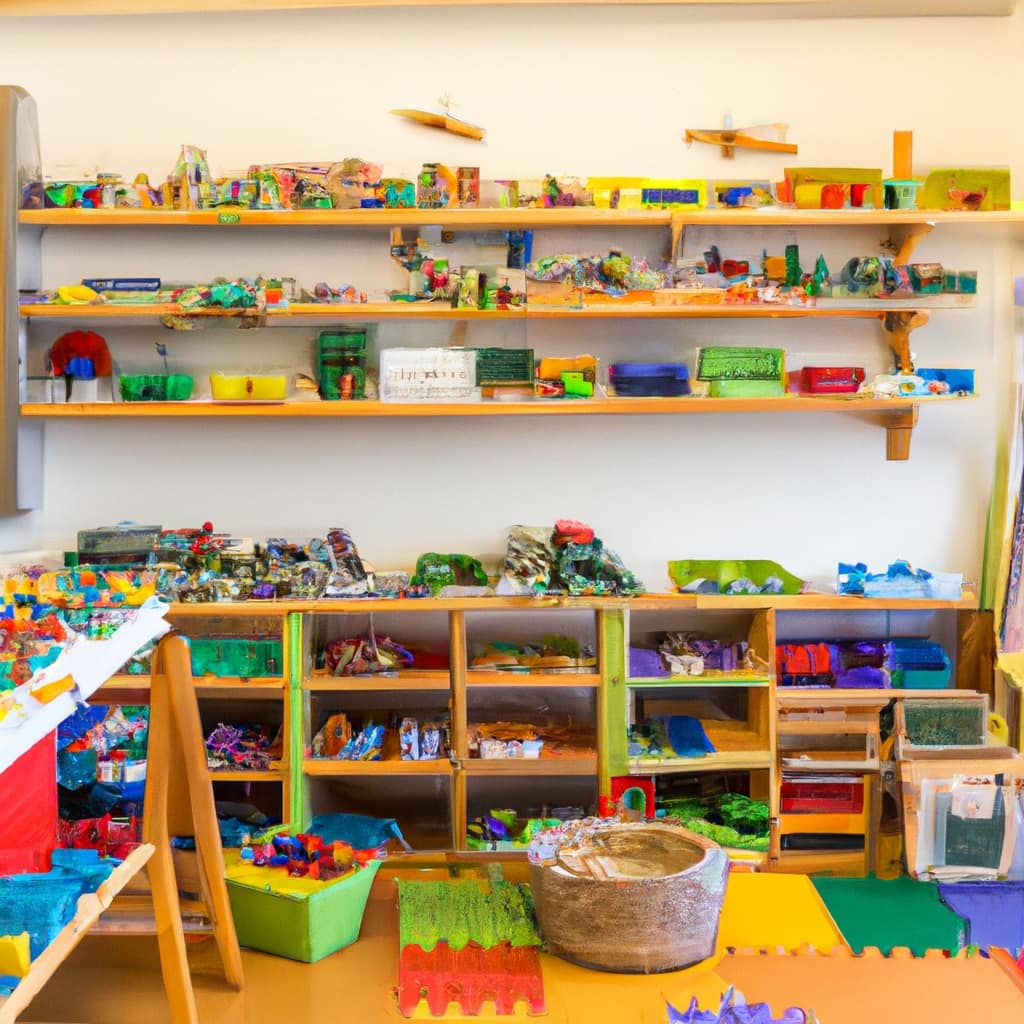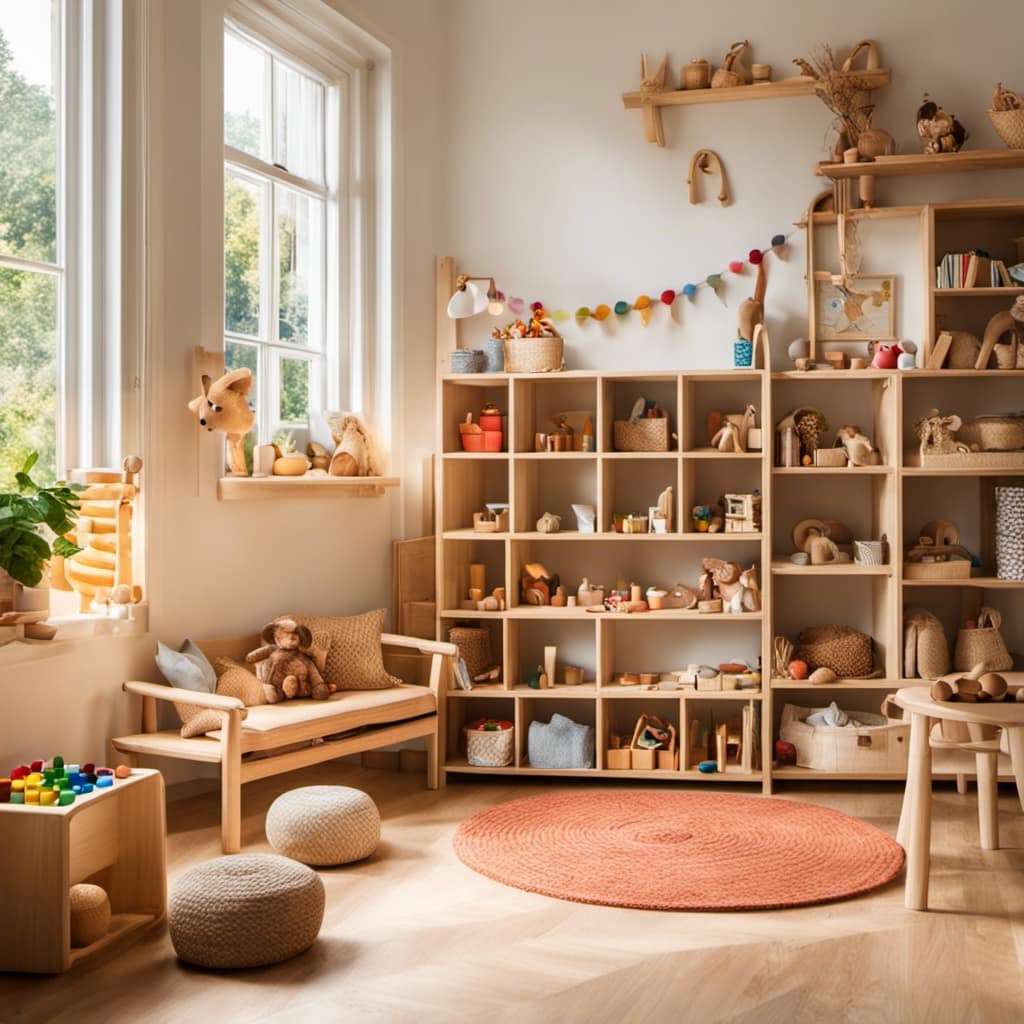I absolutely love making Montessori toys!
The process of selecting the perfect materials, designing educational toys, and ensuring their safety brings me so much joy.
It’s incredible how these toys can foster practical life skills, concentration, problem-solving, and independent play in children.
Plus, they’re perfect for mixed-age classrooms, promoting collaboration and leadership.
But the best part? Sewing Montessori toys allows me to tap into my creativity while creating something meaningful and educational for little ones.
Let’s dive into the world of sewing Montessori toys and explore the materials, design, and safety considerations involved.

Key Takeaways
- Choose durable and safe materials for Montessori toys, such as organic cotton, bamboo, or hemp.
- Use natural fibers like cotton or linen for breathability and gentle contact with children’s skin.
- Ensure that fabrics are certified as non-toxic and free from harmful substances.
- Incorporate Montessori principles in toy design by promoting concentration, problem-solving skills, independent play, and self-correction.
Choosing the Right Materials for Montessori Toys
When choosing materials for Montessori toys, it is important to consider both durability and safety. Eco-friendly options such as organic cotton or bamboo are a good choice. These materials are free from harmful chemicals and pesticides, making them safe for children to interact with. On the other hand, synthetic materials may be more affordable but can potentially contain toxins that can be harmful to children. It is important to strike a balance between durability and affordability when making choices. While organic materials might be more expensive, they often last longer and provide a safer play experience for children. By investing in high-quality materials, we can ensure that Montessori toys are not only engaging and educational but also safe and sustainable for our little ones.
Incorporating Montessori Principles in Toy Design
Promote concentration and problem-solving skills through toy designs that incorporate Montessori principles. By collaborating with educators, we can create toys that not only entertain but also engage children in meaningful learning experiences.
Incorporating sensory elements into toy designs is another crucial aspect. Here are three ways to achieve this:
- Use different textures and materials to stimulate the senses and encourage exploration.
- Incorporate colors and patterns that capture children’s attention and enhance visual perception.
- Create toys that allow for hands-on manipulation and provide opportunities for tactile exploration.
When designing Montessori toys, it is essential to consider the input and expertise of educators. Their insights can help ensure that the toys align with the principles of Montessori education and effectively support children’s development.
Ensuring Safety in Sewing Montessori Toys
When ensuring the safety of sewn Montessori toys, it is important to carefully select materials that are free from harmful substances. Following safety standards and best practices in toy construction is essential to protect children from potential hazards. To help you make informed decisions, here are some key considerations:
| Safety Standards | Best Practices in Toy Construction |
|---|---|
| Use non-toxic and certified fabrics | Choose eco-friendly materials like organic cotton, bamboo, or hemp |
| Avoid small parts or detachable components | Ensure toys are securely stitched to prevent choking hazards |
| Regularly inspect toys for wear and tear | Repair or replace toys as needed |
| Follow age-appropriate guidelines | Design toys that promote concentration and problem-solving skills |
Designing Montessori Toys for Children With Special Needs
Adapting toy designs to accommodate different abilities and motor skills is crucial when creating Montessori toys for children with special needs. These toys should provide sensory stimulation, promote collaboration and leadership skills, and foster an inclusive environment.

Sensory Stimulation: Incorporating various textures and colors in toy designs can engage children’s senses and enhance their learning experience. Different sensory elements such as soft fabrics, ridges, or buttons can provide tactile feedback and promote sensory exploration.
Collaboration and Leadership Skills: Designing toys that encourage cooperative play and teamwork can help children with special needs develop essential social skills. Including toys that require cooperation and problem-solving can foster collaboration and leadership abilities in a supportive and inclusive environment.
Inclusivity: Collaborating with therapists or educators to create toys that meet the specific needs of children with disabilities is crucial. By considering the diverse abilities and requirements of children, we can ensure that our Montessori toys are inclusive and promote engagement for all children.
Essential Sewing Techniques for Montessori Toys
I can practice basic sewing techniques like the straight stitch, whipstitch, and ladder stitch to create Montessori toys. These techniques are essential for ensuring secure stitching and durability of the toys. When sewing Montessori toys, it is important to take safety precautions to prevent accidents. Handling needles and scissors with care is crucial to avoid injuries. Additionally, accuracy and safety should be prioritized when cutting fabric. Regular maintenance and cleaning of the sewing machine is necessary for optimal performance. Following recommended safety guidelines for needle handling, fabric cutting, and machine maintenance is essential. By practicing these basic sewing techniques and taking safety precautions, I can create safe and durable Montessori toys for children to enjoy.
| Basic Sewing Techniques | Safety Precautions in Sewing | Materials for Montessori Toys |
|---|---|---|
| Straight Stitch | Use child-safe materials | Organic cotton |
| Whipstitch | Securely stitch toys | Bamboo |
| Ladder Stitch | Avoid small parts | Hemp |
| Regularly inspect toys | Non-toxic fabrics | |
| Follow age-appropriate guidelines | Natural fibers |
Child-Safe Materials for Montessori Toy Making
Using child-safe materials is crucial to ensure the safety and well-being of children when making Montessori toys. When selecting materials, it is important to consider eco-friendly fabric options that are both safe for children and sustainable for the environment.
Some eco-friendly fabric options to consider include organic cotton, bamboo, or hemp. These materials are free from harmful chemicals and are certified as non-toxic. Additionally, they are gentle on children’s skin and provide breathability.

Another important aspect to consider is the safety precautions in toy making. It is important to avoid small parts or detachable components that could pose a choking hazard. Regularly inspecting toys for wear and tear and following age-appropriate guidelines are also crucial for ensuring the safety of Montessori toys.
Promoting Concentration and Problem-Solving Skills in Toy Design
By creating toys that encourage focused engagement and critical thinking, children can develop their concentration and problem-solving skills. Promoting creativity and imagination in toy design is essential for fostering these cognitive abilities.
Montessori toys that incorporate nature-inspired elements can enhance children’s learning experiences. Nature provides a wealth of inspiration for toy designers, from using natural materials like wood and organic fabrics to incorporating nature-themed motifs and colors. These elements not only stimulate children’s senses but also connect them to the natural world, fostering a sense of wonder and curiosity.
When children engage with toys that evoke the beauty and diversity of nature, they are more likely to explore, experiment, and problem-solve creatively. This type of play promotes holistic development and encourages children to think outside the box, ultimately preparing them for future challenges.
Creating Independent Play and Exploration With Montessori Toys
When designing Montessori toys, it is important to focus on creating open-ended play experiences that foster creativity and imagination. By providing children with toys that encourage independent play and exploration, we are allowing them to develop their own ideas and problem-solving skills.
To achieve this, here are three key strategies to consider:

-
Offer a variety of materials: Provide a range of materials and textures that children can freely manipulate and combine to create their own unique play experiences. This can include fabrics with different colors, patterns, and weights, as well as other sensory elements like buttons, ribbons, and beads.
-
Incorporate versatile designs: Design toys that can be used in multiple ways, allowing children to explore different possibilities and engage in imaginative play. For example, a simple fabric cube can become a building block, a pillow, or even a pretend oven for cooking.
-
Encourage open-ended play: Avoid toys with predetermined functions or specific instructions. Instead, focus on providing materials that allow children to use their imagination and creativity to come up with their own play scenarios. This can involve creating toys without fixed shapes or purposes, allowing children to use them in whatever way they see fit.
Using Self-Correcting Materials in Montessori Toy Design
I can incorporate self-correcting materials into my Montessori toy designs to enhance learning from mistakes.
Self-correcting toys offer numerous benefits for children’s development. They provide opportunities for independent problem-solving and encourage critical thinking skills.
By incorporating mistakes as learning opportunities, children can learn from their errors and develop resilience. Self-correcting materials help children gain a deeper understanding of concepts and promote a growth mindset.

When children make mistakes while using self-correcting toys, they can evaluate their actions, identify errors, and make adjustments accordingly. This process fosters a sense of ownership and responsibility for their learning.
Self-correcting toys also encourage persistence and perseverance, as children are motivated to keep trying until they find the correct solution.
Overall, incorporating self-correcting materials in Montessori toy designs is an effective way to enhance learning and promote a positive attitude towards mistakes.
Adapting Toy Designs for Different Abilities and Motor Skills
When designing Montessori toys, it’s important to consider the diverse needs and abilities of children. One group that requires special attention is children with autism. Adapting toy designs for these children can greatly enhance their play experiences and support their development.
One way to do this is by incorporating sensory elements in toy design. By including different textures, colors, and sounds, these toys can provide sensory stimulation and promote engagement.
Additionally, adapting toy designs for children with autism involves considering their unique motor skills and abilities. Toys that are easy to grasp and manipulate, with clear visual cues and simple instructions, can help these children develop their motor skills and promote independent play.

Frequently Asked Questions
How Can I Ensure That the Materials I Choose for Sewing Montessori Toys Are Eco-Friendly and Safe for Children?
I can ensure that the materials I choose for sewing Montessori toys are eco-friendly and safe for children by selecting organic cotton, bamboo, or hemp, and ensuring they are certified as non-toxic and free from harmful substances.
What Are Some Examples of Self-Correcting Materials That Can Be Incorporated Into Montessori Toy Designs?
Examples of self-correcting materials in Montessori toy designs include puzzles, nesting toys, and shape sorters. These toys allow children to learn from their mistakes and develop problem-solving skills, promoting independent learning and engagement.
How Can I Adapt Toy Designs to Accommodate the Different Abilities and Motor Skills of Children With Special Needs?
To adapt toy designs for children with special needs, I consider their abilities and motor skills. By incorporating inclusive designs and collaborating with experts, I ensure that the toys promote engagement and cater to their specific needs.
Are There Any Specific Guidelines or Regulations I Should Follow When Sewing Montessori Toys to Ensure Their Safety?
When sewing Montessori toys, it’s important to follow specific guidelines and regulations to ensure their safety. This includes using child-safe materials, securely stitching toys, avoiding small parts, and regularly inspecting for wear and tear.
Can You Provide Some Tips for Maintaining and Cleaning a Sewing Machine Used for Making Montessori Toys?
Maintaining and cleaning a sewing machine is essential for optimal performance. To keep it in good shape, regularly oil the machine, remove lint buildup, and wipe down the surfaces. Follow the manufacturer’s instructions for specific maintenance tasks.
Conclusion
In conclusion, sewing Montessori toys requires careful consideration of materials, design, and safety. By prioritizing durability and eco-friendly options, we can create toys that are safe and long-lasting.

Incorporating Montessori principles in the design encourages practical life activities, concentration, and problem-solving skills. Safety precautions, such as securely stitching toys and avoiding small parts, are essential to protect children.
Additionally, adapting designs for children with special needs and collaborating with therapists ensures inclusivity. With the right techniques and design elements, Montessori toys promote independent play and foster a love for learning.











